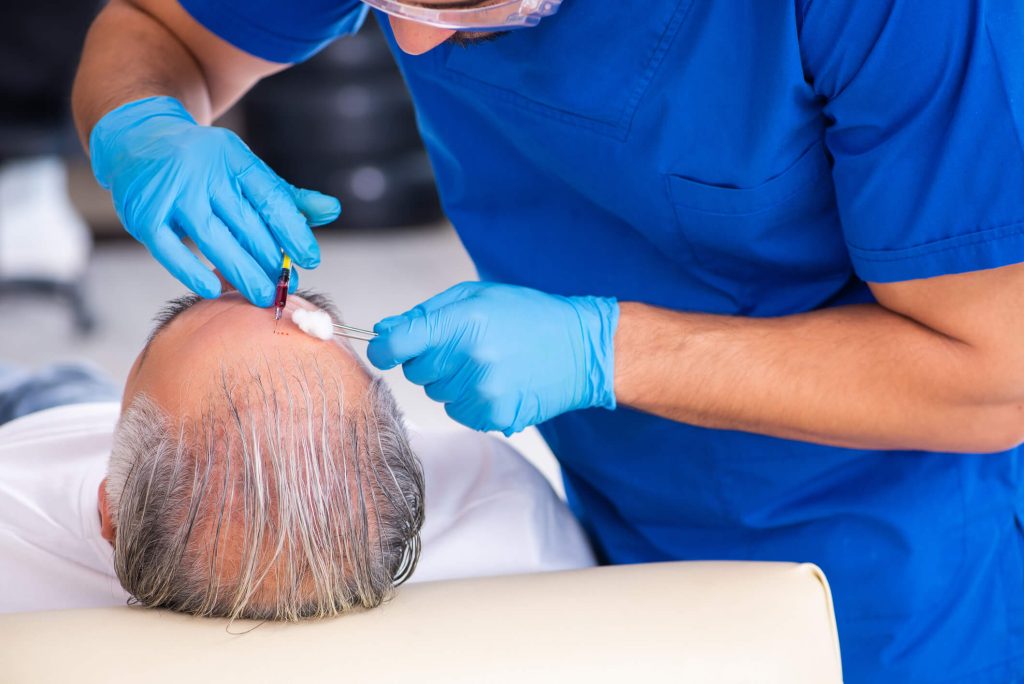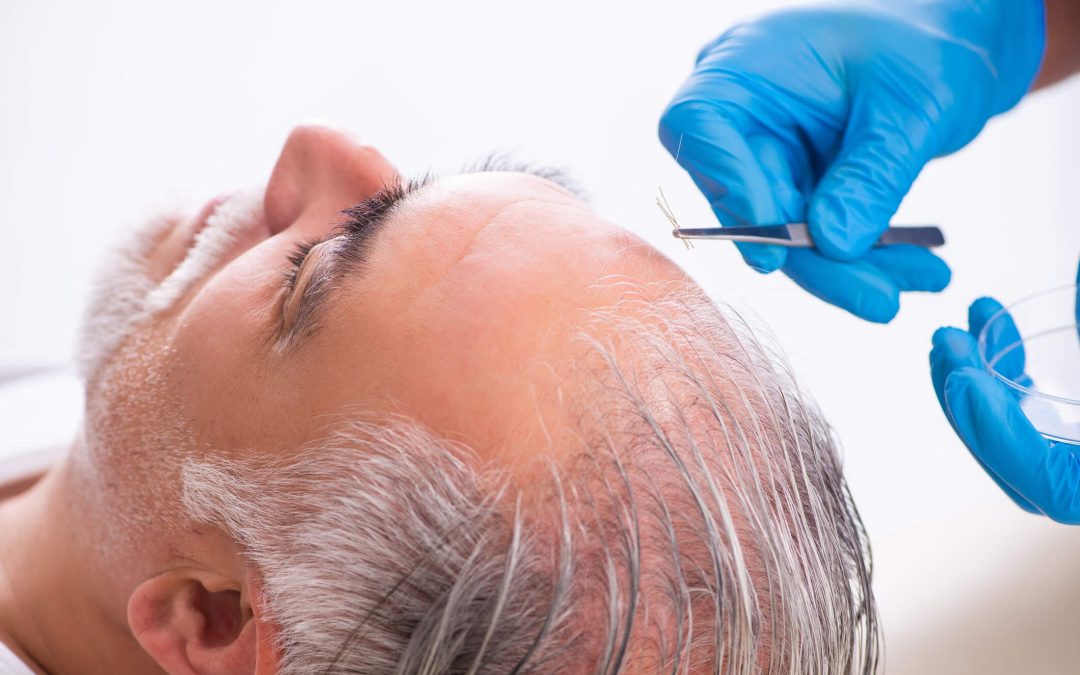A hair transplant may be possible to reverse hair loss. However, a hair transplant isn’t a quick fix, and the results may not show up for over a year. Exercising patience and adhering to your surgeon’s hair transplant recovery and aftercare instructions following the procedure is crucial. This article gives a thorough timeline of the growth you might anticipate following hair transplant surgery.
Stages Of Hair Growth
It’s critical to comprehend hair growth before going over the recovery time after a hair transplant procedure. The hair growth cycle and loss consists of four main phases. Hair grows in stages. These are the following:
- Anagen (growth phase)
- Catagen (transition phase)
- Telogen (resting phase)
- Exogen (hair shedding phase)
Let’s look at each of the four phases in greater detail:
- Anagen: Of the four phases, this one is the longest and is the growth phase. Hairs are in the anagen phase for three to five years. Some hair, though, might continue to grow for seven years. During the anagen stage, hairs develop until they reach the end of their lives when they are forced out by the hair follicles. Compared to facial or pubic hair, scalp hair has a longer anagen phase.
- Catagen: After the anagen phase comes this transitional stage. The hair follicles shrink, and growth slows down over ten days. During the last stages of its growth, the hair remains on the scalp after separating from the hair follicle. At any given time, three to five percent of hairs are within the catagen phase.
- Telogen: The transitional catagen phase is followed by the resting phase. After a hair stops growing, it will stay in place for around three months. New hairs grow in the hair follicles throughout this period. Ten to fifteen percent of hairs are within the telogen phase at any given time.
- Exogen: The telogen phase that came before might be considered continuing into the exogen phase, which lasts two to five months. During exogen, hair is detached from the follicle, does not develop, and will fall out. Shedding of hair may occur due to sleeping, washing, or brushing. New hair forms in the hair follicles, while the old hair falls out throughout the exogen phase.
How Do Hair Transplants Work?
A hair transplant is performed at a hospital or doctor’s office, just like any other medical surgery. During the one-day outpatient procedure, patients usually receive a local anesthetic. After treatment, most patients can drive themselves home.
During the procedure, hair follicles from the donor site are transferred to the patient’s balding scalp areas. These follicles are typically taken from the patient’s sides or back. These implanted follicular grafts eventually generate hair like natural hair.
During the process, follicular unit extraction/excision (FUE) and follicular unit transplantation (FUT) are the two main techniques used to collect follicles.
The patient had a thin strip of skin removed from the back of their head by the doctor using the FUT procedure. After being separated from the strip, the person’s follicular grafts are inserted into the appropriate scalp areas.
On the other hand, with a FUE hair transplant, each graft from the patient’s skull can be removed individually. The doctor or physician assistant harvests the grafts by performing circular punch wounds no wider than 1 mm in diameter. This minimally invasive procedure enables speedy recovery; the tiny wounds heal in 1-2 days and become barely noticeable afterward.
The best technique for you will be determined in consultation with your physician.
How to Prepare Before Your Hair Transplant Surgery
The extent to which you prepare before the time may impact healing timelines and guarantee the success of hair transplant results. The following helpful tips can help you improve and support your healing process:
- Daily Head Massages: Incorporate fifteen- to twenty-minute head massages before the surgery. Aim to perform them daily, as this exercise improves the elasticity of the scalp and activates the hair follicles.
- Avoid Using Blood Thinners: Clear prescription drugs like blood thinners until your primary care physician approves. This could also apply to over-the-counter blood thinners like ibuprofen and aspirin.
- Sun Protection: In the days before the transplant, avoid being in the sun too much. Wearing a full-coverage hat is a great way to prevent irritation and provide ideal conditions for the procedure if you must spend time outside.
- Stop Using Hair Loss Medication: Some medications for hair loss may make your skin more sensitive. During the consultation, ask your Orange County surgeon if you have any questions about whether you should discontinue taking your medicine.
- Avoid Getting a Haircut: Give your hair time to grow naturally before the procedure. A sufficient amount of hair is needed in the donor area for the process to be successful.
Following these easy steps, you can improve the hair transplant experience by promoting a more seamless recovery. At Neograft Hair Restoration Orange County, we know that each person’s hair restoration journey is unique and that various people will require varying levels of preparation. For this reason, when you speak with an Orange County doctor, you will be given a customized strategy.

Month by Month Hair Transplant Timeline
Let’s move on to the interesting part: the growth timeline for hair transplants. We understand that you’re sick of staring at your receding hairline or expanding bald spot and are ready for a change. It is crucial to remember that results are not immediate and that each person’s timing will differ. For this reason, an Orange County physician will evaluate your needs and guide you through a growth chart for hair transplants during your appointment to let you know what to anticipate at each phase.
Hair Transplant After 7 Days
The hair transplant timeline will start, covering what to anticipate immediately following a transplant and on to the seven-day milestone.
After your hair transplant, the recipient area—where the new hair will grow—and the donor area—where the hair grafts were taken from—will mend. These places will be wrapped, and it’s expected to feel pain and discomfort first, followed by itching as the scabs develop and fall off. You must follow the aftercare instructions your clinic has given you throughout this period.
Wear a cap (or headwear provided by the clinic) if you go outdoors to protect yourself against environmental influences. Use prescription pain relievers if you experience pain or have difficulties sleeping in the first seven days following your hair transplant procedure.
Additionally, you shouldn’t scratch your scalp, rub your hair with towels, or wash your hair until told to do so—usually five days after receiving a hair transplant. You should also refrain from doing any strenuous physical activity for two weeks.
Hair Transplant After 2 Weeks
After the hair transplant, you will experience additional changes in two weeks.
Although the swelling should have decreased, you may still experience some redness and itching until the scabs fall off naturally. The healing process is going to be well underway. Exercise will not put as much strain on your scalp, and you must be able to sleep comfortably in any position.
You may notice some hair shedding in the recipient area at this point, which is a natural aspect of the hair growth cycle. New hair is growing in the follicles and will eventually start to grow.
You should return to your regular activities during this period, exercise, and soak the head in a bath to help the scabs come off. There’s no need to try to remove any more scabs by picking.
Hair Transplant After One Month
More hair will eventually fall out and enter the resting phase at the recipient location. Shedding following a hair transplant is primarily caused by this fundamental process. The recipient area of the scalp might look patchy in growth since the hairs are at different stages in the growth cycle. This is normal and should not be a reason for alarm. New hair should’ve sprouted and covered the area at the donor site.
You should contact our clinic if you see any lingering signs of inflammation (skin still quite red and hot to the touch). Your transplanted hair will naturally fall out as part of the healing process, so don’t worry.
Hair Transplant After Two Months
At two months, you will observe the continuation of the shedding and hair growth cycle mentioned in the previous section. Every person will experience this at a different pace.
Some areas of the recipient region will undergo various phases of the hair growth cycle, so you should be patient and not worry about any patchiness on the scalp.
Hair Transplant After Three Months
You should start to see the new hair growing in the third month. These new hairs will probably have a “wispy” appearance since they are thin and nearly transparent. Their immaturity is the cause of this.
You’ll need to be patient while your new hair develops gradually. Although these new hairs may resemble body hair, you shouldn’t be alarmed by their appearance. Your hair will grow stronger and thicker over time.
Four Months Post-Hair Transplant
More hair must have grown by the fourth month. Even so, the growth may first be uneven before becoming more consistent.
Six Months Post-Hair Transplant
This is the end of what some people call the “ugly duckling stage.” Your newly grown hair will have undergone a noticeable growth spurt, growing thicker and stronger. Over the coming months, this will keep happening.
It’s important to remember that various situations, including the recipient area’s location and the hair transplant procedure, can influence growth rates. At this point, you shouldn’t anticipate the result of the hair transplant surgery.
9–12 Months Hair Transplant
Your new hair will keep getting thicker as it grows at a pace of about 1-2 cm monthly.
If your hair has grown to a respectable length, you can style and trim it however you like.
12-18 Months Hair Transplant
You should notice the full effect of your hair transplant within a year to eighteen months. Every transplanted hair should have grown through the scalp, fully darkening and thickening.
You can care for and enjoy your new hair like in another situation.
Hair Transplant Side Effects
FUE hair transplants can effectively and permanently treat hair loss. Over time, research and improvements in the process have made hair transplants a less intrusive and safer choice for everyone.
However, it is still a medical treatment that requires scalp incisions and the use of anesthesia. Despite being regarded as a less invasive treatment, a patient must still consider a hair transplant’s risks and adverse effects.
Possible short-term side effects include:
- Swelling
- Scabbing
- Bleeding
- Itching
- Infections
- Temporary hair loss following surgery in affected areas
For additional information on the potential adverse effects of a hair transplant, consult our surgeon. Alternatively, you can schedule a consultation with one of our skilled surgeons.
Is the Hair Transplant Recovery Process Painful?
The hair transplant recovery process is generally pain-free, primarily due to local sedation during the procedure. Patients report minimal discomfort and little bleeding, making the recovery process smooth and straightforward. There is no risk of nerve injury, and patients can expect almost immediate recovery time. The procedure is minimally invasive and does not involve cutting the scalp, which results in no visible scarring. This allows patients to return to their routine activities with confidence.
Following the surgery, specific instructions will be provided concerning showering, shampooing, and other hygiene aspects. These precautions are essential to ensure a successful recovery process. Patients are typically advised to briefly avoid strenuous activity and sleep with their heads on a pillow to minimize swelling. Follow-up appointments will be scheduled to monitor progress and provide additional advice as needed.
Swelling after a hair transplant
Swelling on the scalp is a common side effect during the hair transplant recovery process. This symptom usually begins a few days after the surgery and resolves within ten to fourteen days. In addition to swelling, patients might experience redness and scabbing at the transplant site. However, these symptoms are normal and subside over time.
To manage swelling, patients are often advised to follow specific aftercare instructions, including gentle showering and avoiding direct pressure on the scalp. Using cold compresses and keeping the head elevated can also help reduce swelling. Patients should attend all follow-up appointments to ensure that everything is healing as expected and to receive any necessary adjustments to their recovery plan.
George Brennan: Hair Restoration Surgeon in Newport Beach, California
Dr. George Brennan is a renowned hair restoration surgeon based in Newport Beach, California, specializing in the Follicular Unit Extraction (FUE) technique. Known for his expertise and personalized care, Dr. Brennan ensures that each patient receives a tailored treatment plan to meet their needs and expectations. He provides a 5-star solution for hair restoration, aiming for permanent and natural-looking outcomes without side effects.
During these consultations, he addresses all concerns and provides detailed explanations of the recovery process, offering clear advice on what to expect. The clinic employs the latest technology to diagnose hair issues and recommend the most efficient treatments.
Patients can rest assured knowing they will receive one-on-one service throughout their journey, from the initial consultation to post-operative visits. This comprehensive approach ensures that every procedure aspect, including the recovery timeline, is managed precisely and carefully. Follow-up appointments are integral to this process, allowing Dr. Brennan to track progress and make any necessary adjustments to ensure optimal results.
Contact us today for more information on the hair transplant recovery process and to schedule a consultation with Dr. George Brennan.
Conclusion
Like any surgical operation, a hair transplant’s success depends on following your doctor’s instructions. After undergoing this outpatient treatment, patients usually notice the full outcome of their transplant in a year. Even better, these results are long-lasting.
Neograft Hair Restoration Orange County can help determine which hair loss treatment is ideal. Make an appointment for a consultation with one of our qualified experts to discuss potential solutions to your hair restoration goals. If you’re considering a hair transplant in Newport Beach CA, our experts can connect you with an Orange County surgeon who can address your concerns regarding hair restoration treatments.



Recent Comments